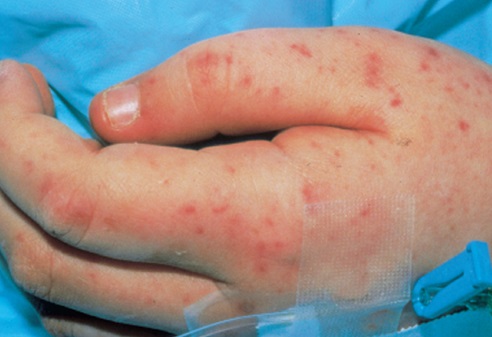Petechiae are tiny brown, red, or purple spots that appear under the skin. They can be about the size of a pinprick but do not itch or blanch when you press on them. It is possible that your child has a few of these spots or clusters of them, and they can appear on the chest, face, feet, or even stomach. Petechiae are not always a cause for concern, but they sometimes indicate serious problems as well.

What Causes Petechiae in Children?
There are tiny blood vessels underneath the skin. They can burst anytime and cause petechiae in anyone. Children can have them after a bout of vomiting or coughing. They usually appear on the face.
It is possible to notice widespread petechiae, which usually indicates an underlying serious disorder. This may be the case with disorders such as a blood-clotting disorder called idiopathic thrombocytopenia purpura (ITP). Similarly, meningococcal disease caused by a bacterial infection of the lining between the skull and the brain can also cause widespread petechiae in children. A widespread infection of the bloodstream called meningococcemia may also lead to petechiae.
Here are some of the causes why your child has developed those tiny spots.
- Prolonged Straining: Your child may develop petechiae because of prolonged straining during certain activities. Some of these activities include vomiting, coughing, and crying.
- Certain Medications: Taking certain medications may well be the reason behind those tiny spots on your child's chest or anywhere on the body. Some of these medications include chloral hydrate, anticoagulants, naproxen, indomethacin, penicillin, and nitrofurantoin.
- Infectious Diseases: A number of viral, fungal and bacterial infections can cause petechiae. Some of the most common infectious diseases are scarlet fever, strep throat, viral hemorrhagic fever, meningococcemia, Rocky Mountain spotted fever, and sepsis.
- Other Medical Conditions: Certain medical conditions such as leukemia, thrombocytopenia, vitamin K deficiency, and vitamin C deficiency can cause petechiae as well.
In addition, child abuse involving smothering or strangulation can cause petechiae in the eyes and face. Similarly, spanking, biting, and crush injuries can cause petechiae of the neck, face, and chest.
How to Deal with Petechiae in Children
You should talk to a doctor if your child has petechiae, especially if the spots are right below the chest. If they are not vomiting, this usually means a less-scary virus is at work. Your doctor may order blood tests to diagnose meningococcal disease or ITP.
While petechiae usually fade without treatment, it is important to identify the underlying cause. Your doctor may also prescribe medication or recommend therapies for vomiting or a heavy cough. Make sure that your child takes medications as directed by the doctor. Hospital stay is usually necessary in case of serious underlying medical conditions. Here are some other ways to deal with petechiae in children:
1. Identify the Causative Agent
In case your child has recently started a new medication, this could very well be the reason why he/she has developed those spots. The simplest treatment is to stop taking that medication. However, it is better to talk to the doctor before you stop giving your child any medication. Your doctor may consider the symptoms and replace your child's medications.
2. Antibiotics
Your doctor will prescribe antibiotics in case a bacterial infection is the underlying cause of petechiae. Antibiotics help clear the infection, and once the infection is gone, the spots will disappear as well.
3. Cold Compressions
Sometimes, an injury to the blood capillaries can cause petechiae in children. If that is the case, you should consider applying ice or cold compression on the affected area. This will help reduce the appearance of spots. Keep in mind that you should not be applying ice directly on the skin; instead, keep a paper towel between the ice pack and the skin of your child.
4. Platelet Transfusion
Your child may develop petechiae when his/her platelet count is on the lower side. Your doctor will confirm this after ordering blood tests. If that is the underlying cause, your doctor may recommend platelet transfusion to resolve the issue.
5. Surgery
In rare cases, leukemia or other malignant conditions cause petechiae. This is when your doctor may recommend surgery to manage things better.
